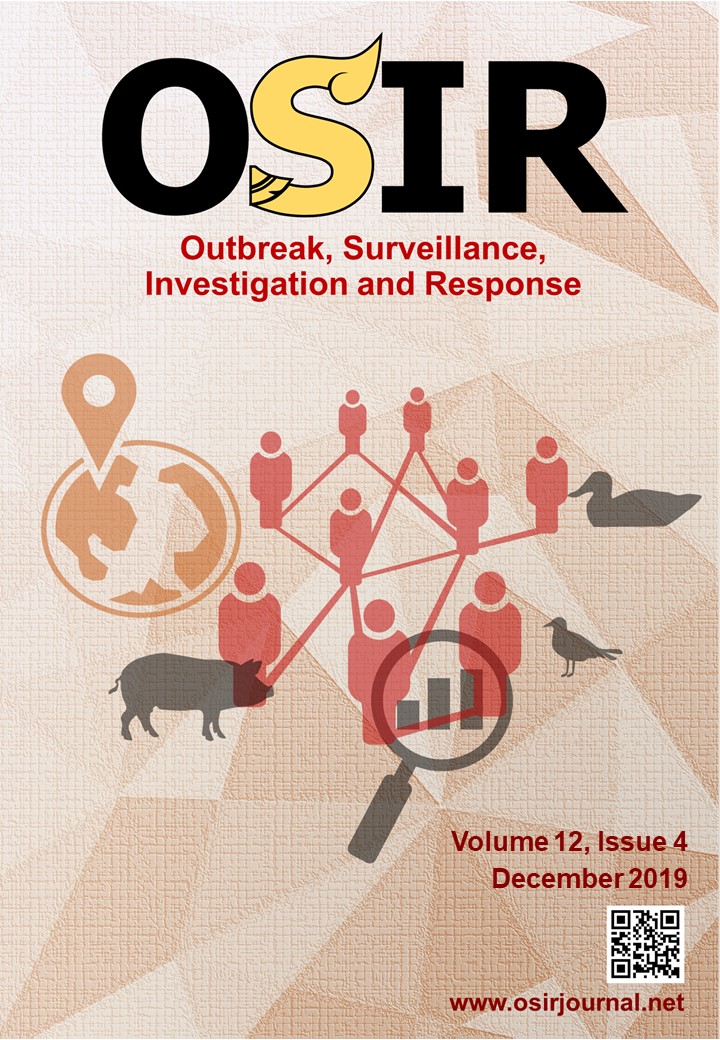Field Evaluation of the Syphilis Surveillance System at Mae Sot Hospital, Tak Province, Thailand
DOI:
https://doi.org/10.59096/osir.v12i4.262930Keywords:
syphilis, surveillance system, reporting system, ThailandAbstract
Evaluation of the syphilis surveillance system was conducted at Mae Sot Hospital, Mae Sot District, Tak Province, Thailand during 13-16 Aug 2019. The objectives of the evaluation were to describe the usefulness and to evaluate the performance of the system. A cross-sectional study was carried out to assess the reporting system of syphilis. Medical records were reviewed from all possible data sources. Semi-structured questionnaires were used for in-depth interviews with a policy maker, health care providers, laboratory technicians and information and technology personnel. The sensitivity of reporting syphilis cases into Thailand's national notifiable disease surveillance reporting system was about 67%, while the positive predictive value of reporting was reached 100%. The data quality of reporting reached almost 100%. The reported data represented the true cases in terms of sex and age. The majority of participants found the reporting system of syphilis cases to be useful, acceptable, simple and stable. The majority of missed reported cases were migrants. Incomplete diagnosis and coding were key concerns. The Epidemiology Unit at the hospital should analyze Thai and foreign cases separately to represent the true situation in the border area. Cooperation amongst within-hospital units for better capture of syphilis cases in hospital is recommended.
References
World Health Organization. Nature Reviews Microbiology. June 2004;2:448.
Newman L, Rowley J, Vander Hoorn S, Wijesooriya NS, Unemo M, Low N, et al. Global Estimates of the Prevalence and Incidence of Four Curable Sexually Transmitted Infections in 2012 Based on Systematic Review and Global Reporting. Plos One. 2015 Dec 8;10(12):e0143304.
World Health Organization. Sexually transmitted infections [Internet] 2018. [cited 2019 Aug 8]. Available from: <https://www.who.int/gho/sti/en/>
Centre for Disease Control and Prevention, Atlanta. HIV and syphilis infection among men who have sex with men, Bangkok, Thailand, 2005–2011. Morbidity and mortality weekly report. 2013 Jun 28;62:518-520.
Yingyong T. Introduction to R506 and syphilis surveillance system [unpublished lecture note]. IFETP, Bureau of Epidemiology, Ministry of Public Health, Thailand; lecture given 2019 Aug 6.
Mathew J, Paula W, James M, Arthur J, William R. Evaluation of syndromic surveillance systems in 6 US State and local health departments. J Public Health Manag Pract. 2018 May/Jun;24(3):235-240.
Mon Thet S, Rattanathumsakul T, Puangmanee D, Khine San K, ThanWint P, Wahab AB, et al. Field Evaluation of Malaria Surveillance System in Sai Yok District, Kanchanaburi Province, Thailand. Outbreak, Surveillance, Investigation & Response (OSIR) Journal. 2019 Jun;12(2):38-45.
Cardoso AR, Araújo MA, Andrade RF, Saraceni V, Miranda AE, Dourado MI. Underreporting of congenital syphilis as a cause of fetal and infant deaths in northeastern Brazil. Plos One. 2016 Dec 12;11(12):e0167255.
Martin D, Bertrand J, McKegney C, Thompson L, Belongia E, Mills W. Congenital syphilis surveillance and newborn evaluation in a low-incidence state. Arc Pediatr Adolesc Med. 2001 Feb;155(2):140-4.
Downloads
Published
How to Cite
Issue
Section
License
Copyright (c) 2023 Outbreak, Surveillance, Investigation & Response (OSIR) Journal

This work is licensed under a Creative Commons Attribution-NonCommercial-NoDerivatives 4.0 International License.









